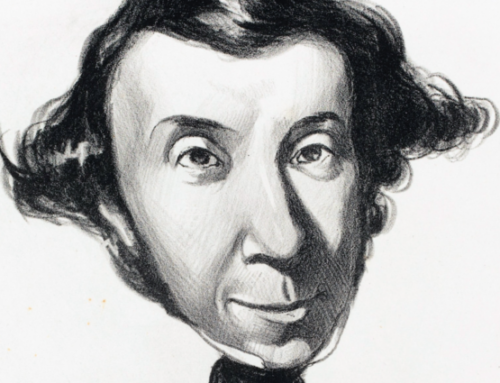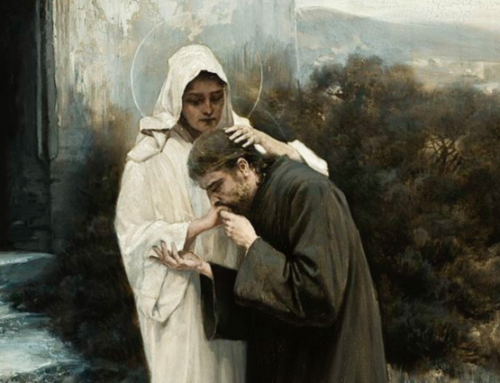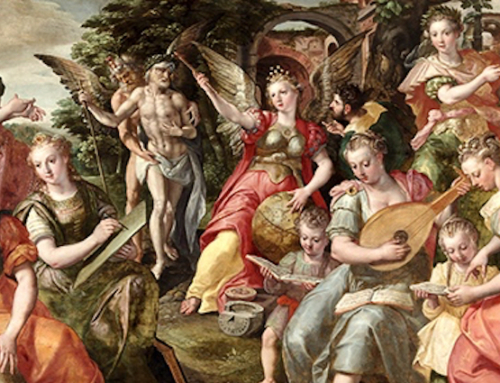While much Western art immerses us in the richness of this world with its spacial and emotional realism, the Eastern Orthodox tradition uses only painted images, with icons of Christ, Mary, and the saints functioning as “windows into heaven,” by way of stylized forms that convey a Platonic ideal of beauty and truth.
We live in an era in which words are routinely diluted of their meaning. One feels the need, especially around Christmas, to go back to the root senses of things, to their primitive origins. Consider the words “icon” and “iconic.” They have been so trivialized and commercialized that one can easily forget their original, concrete meaning in the Christian church—a meaning that becomes clear the minute you walk in a church of the Eastern tradition, where the glow of sacred images dispels the vulgar world outside.
For a long time I have admired icons—their objectivity, simplicity, calm, and timelessness. I wish they were more frequently seen in our churches. While much Western art immerses us in the richness of this world with its spacial and emotional realism, icons function as “windows into heaven,” with stylized forms that convey a Platonic ideal of beauty and truth.
To gain deeper insight into the aesthetics of icons, I spoke with Christina Kokoshari, a young artist in New York City who makes some fine examples. Born in Albania and trained in Greece, Christina now runs a home art studio in Astoria, Queens. While some of her work is secular (including some lovely impressionist landscapes), a good portion is devoted to sacred icons on wood panel or canvas. These grow directly out of her intense Eastern Orthodox faith, which she learned as a child during the waning days of Communism.
Of all the Communist governments, Albania’s was particularly ruthless in its repression of religion. Christina’s parents grew up under this regime, which in 1967 declared the world’s first constitutionally atheist state. By Christina’s childhood years the freeze was beginning to thaw and, at the age of nine, she was able to be baptized in the Orthodox Church. At this time Albanians were beginning to travel abroad to Italy, Greece, and other countries to find opportunities in the wider world.
Albania has had a complex history. The country lies along the fault line of the Great Schism, with a predominantly Catholic north and Orthodox south. Long under the domination of the Ottoman Turks, it shows the legacy with a sizable Muslim population and a number of mosques. In the 15th century the Albanian national hero, Skanderbeg, thwarted the Muslim advance into Western Europe.
Life in an Orthodox land
This was historical background to a girl growing up in the beautiful seaside city of Durrës on the Adriatic coast. Christina inherited her artistic passion from her parents, both of them art teachers. Her father ran an art studio and often painted outdoors, believing with the Impressionists that “Nature is the best teacher.” Her mother was known to her students as “Teacher of Flowers” for her loving manner of instruction.
With her parents out teaching and her older sister and brother at school, Christina was often home alone and, dreaming about being a teacher herself, would line up her dolls in a row and give them lessons, punishing the more recalcitrant ones by banishing them to the corner. Solitude was sweet, giving her ample time to meditate and plan for the future.
After the fall of Communism, Christina’s father began creating religious pictures, including a fine Agony in the Garden. Many of his icons filled the Church of St. John the Russian in Prokopi, where Christina would spend hours praying next to the saintly relics. “I was very fond of the church and passionate about my life in Christ,” she recalls. It was there that she met a priest, Father Nicholas (she refers to him as her “Santa”) who gifted her with some black-and-white icons he had painted. These icons inspired her to overcome her awe of her parents’ work and find her own way as an artist.
Moving with her family to Greece, Christina attended college for graphic design, followed by stints studying pharmacology and English literature (the latter at the New York College in Athens). It was a solid backbone of cultural and medicinal knowledge which enriches her life to this day.
Working in Icons
Christina sees her icon work as a continuation of the earliest period of Christian iconography, the second to the fourth centuries, a style in which she alone “feels fully satisfied.” These early icon makers built on the base of Greco-Roman art and established classic symbolic motifs: the fish and shepherd to represent Christ, the dove to suggest the Holy Spirit, the peacock as a symbol of the Resurrection.
“Although with each succeeding century iconography became more mature and stylized,” Christina says, “I find joy in the simplicity of the first Christian icon making.”
This reminds me of my own liking for the Italian art of the 1300s, itself much closer to the spirit of Byzantine icons than to the more naturalistic art of the Renaissance.
Fundamental to Christina’s approach is the idea that iconography is “an art separated from other art forms, bearing its own rules and techniques.” Traditional materials include wood board, linen fabric, gesso and glues, pigments, vinegar, and temperas (paints made from colored pigments and a binder of egg yolk, water and oil). And gold leaf, which gives the glowing background to so many icons, a foretaste of the world beyond. Those who go deeply into the history of icons will encounter several distinct historical styles, including Byzantine (current from the 4th to 14th centuries and focused on mosaics), Egyptian, and Russian.
The sense that icons are an art set apart particularly intrigues me. Christina explains: “The art of icon making is connected with the world of faith and spirituality, much of which we do not see but long for. For this reason, I prefer to make simple, humble icons that instead of giving me the space to become an art critic, will maintain my warm desire for prayer and focus on true beauty.”
Art as an exercise in humility—a novel idea, rarely followed in the West since the Renaissance and, in more recent days, practically unheard of.
Instead of making us into critics, icons are meant to improve our souls. “They invite us to imitate the virtues of the personages depicted,” Christina says, “for our sanctification and holy transformation. They are great instructors on matters of the Christian faith.”
The Triumph of Icons
When speaking of the importance of icons in her tradition, Christina cites the Feast of the Triumph of Orthodoxy, which every year commemorates the victory of the proponents of icons over the forces of Iconoclasm. For a philosophical dispute, the Iconoclastic Controversy (8th and 9th centuries) raged with unusual passion. At issue was whether Christ, Mary (the Theotokos), and the saints should be represented pictorially, or whether this was a form of idolatry. That this issue came to a head in the 700s shows that the fervor for icons had been on the rise during the preceding centuries.
For Christina, the answer to the problem is simple and may be found in Genesis 1:26: “In the beginning, God created man according to his own image.”
“How else do we show reverence to each other,” she asks, “except that we have been made according to God’s image?”
She also cites the words of St. Basil, “The honor which is given to the icon, passes over to the prototype.” Thus, icons are properly understood as copies of a divine Original.
Unlike the Western Catholic tradition, where Christ, Mary, and the saints are often depicted in three-dimensional form, the Eastern tradition uses only painted images. Even the crucifix is a painted icon in Orthodoxy. This strikes me as analogous to the Orthodox restriction of liturgical music to the human voice, unaided by instruments. In both cases, the limitation (versus Western richness and exuberance) produces an inner concentration and purity.
The completion of an icon marks not an ending but a beginning. Christina treats hers with fixing spray for preservation, then brings them to a church to be blessed, accompanied by holy water and the reading of prayers. If they don’t end up adorning a church, icons may find their way into Orthodox homes as part of an icon corner, often elaborately laid out with candles and incense. Instead of museum pieces, icons become a part of everyday life, to be contemplated, prayed over, kissed, and venerated.
It’s worth nothing that originality and individualism, so valued in the West, do not hold pride of place in the world of icons. It is natural and expected that the icon maker will base his work on hallowed models. Christina’s Trinity Icon, for example, is based on a prototype from the revered 14th century artist Andrei Rublev. This image bears comment because it is so unlike Western depictions of the Holy Trinity.
The Secret to the Trinity Icon
Most surprising to us is the quasi-angelic form of the three figures. They indeed represent God the Father, Son, and Holy Spirit, and as is often the case in iconography, each visual detail tells. The rod held by each figure symbolizes their equality in the Godhead, and the similarity of their facial features signifies their oneness. The blue cloak worn by each is the color of their divinity. The Holy Spirit wears green, signifying new life.
The three divine Persons relate to each other in a circular movement of gestures. The Father blesses and approves of the Son. Inclining his head in submission to the Father, the Son gestures to the cup of the Passion which he is to drink. The Spirit comforts the Son and shares in his mission.
A further layer of meaning to the Trinity Icon—and this is perhaps most surprising of all—is that it is based on the Old Testament. The story of Abraham and the three visitors (Genesis 18:1-15) has often been seen as a pre-revelation of the doctrine of the Trinity. Christina comments: “When we participate in the hospitality of Abraham to the Lord we discover that we are really responding to the hospitality of the Holy Trinity.”
Icons are only one part of Christina’s artistic practice. She divides her work into three additional categories: medieval, folk, and impressionist—the first two sharing with iconography the lack of realism (including realistic perspective) as we understand it. These styles Christina treats as legitimate and living traditions. As a lover of the farming life, she finds folk art “cheerful, attractive and loving,” a style in which exaggeration and naive distortions play a part. “In folk art,” she says, “it is something very normal when you see the cat bigger than the tree” (her term for this is “adventurous hypostasis”). The Impressionism of Monet and Renoir has influenced her to create enticing worlds that viewers will desire to enter.
Liturgical music is another of Christina’s accomplishments, and she frequently cantors at Orthodox churches in New York. To embody a total artistic life in this way is a rare gift. Yet the icon still holds a central place, and hearing her speak about her work has enlarged my understanding of this special art form. In a modern world where images have become cheapened, a lovingly made icon can help purify and sanctify us. In beholding it, we turn away from false idols to Christ, the “image of the invisible God.”
Please visit Ms. Kokoshari’s website for more information on her artistry. All images courtesy of Ms. Kokoshari.
The Imaginative Conservative applies the principle of appreciation to the discussion of culture and politics as we approach dialogue with magnanimity rather than with mere civility. Will you help us remain a refreshing oasis in the increasingly contentious arena of modern discourse? Please consider donating now.











Leave A Comment